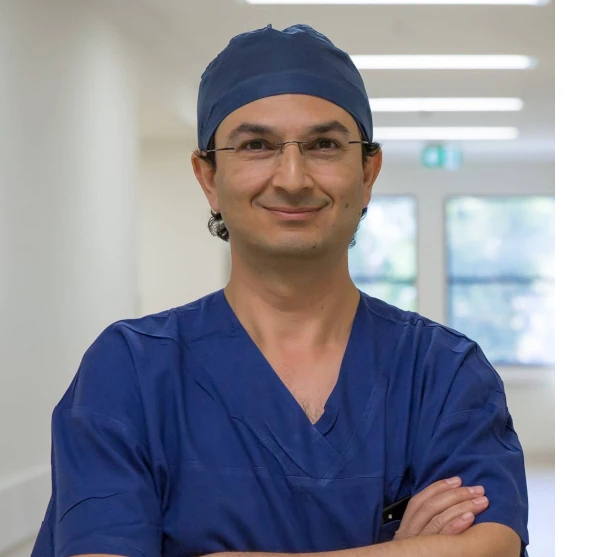
While we were writing and editing our feature article about osseointegration for the current print edition of Amplitude, two Australian media outlets were teeing up an explosive article about the world’s most prolific OI surgeon, Munjed al Muderis. In a long segment on 60 Minutes Australia that appeared last week, al Muderis received withering criticism from former patients and fellow doctors. A pair of companion articles in the Sydney Morning Herald (see part one and part two) detailed further allegations against al Muderis, who has performed hundreds of OI operations on amputees from around the world, including in the United States.
The reports are damning and well substantiated—al Muderis’s medical insurance has been put on hold, leaving him unable to perform OI surgery while the insurer conducts its own investigation. It’s a humbling blow for the surgeon, a global celebrity who’s won accolades from Queen Elizabeth II, the International Red Cross, Amnesty International, and the Australian government. But the media scrutiny could also have an impact on the broader limb-loss community. Since al Muderis is such a high-profile promoter of osseointegration, there’s a danger that the sensational charges against him could taint amputees’ perceptions of OI in general.
That would be an unfortunate outcome. Even if al Muderis is as bad as his detractors say (and he probably isn’t), OI remains an extraordinarily promising technology with enormous potential benefits for amputees. To help put things in context, we asked some American OI patients and surgeons what lessons US amputees can, and should, learn from the news Down Under. Here are some key takeaways.
1. Take ownership of your own outcomes.
“I’ve always been an advocate for myself,” says Cindy Asch-Martin, an al Muderis patient who was quoted in both the 60 Minutes and Herald reports. (She also appears in Amplitude’s OI feature). “People need to act as their own advocates and take charge of their own health care.”
That mindset runs counter to common expectations about OI, Asch-Martin believes. Instead of viewing OI as the first step in an ongoing commitment to self-care, too many patients regard themselves as passive recipients of a one-time surgical solution. It’s an easy trap to fall into, given the prevalence of amputees who rave about OI’s transformative effect on their lives. But while OI can relieve patients of socket-related miseries, it comes with its own complications and burdens—and those have to be planned for rather than downplayed, Asch-Martin says.
Asked to name specific ways that patients can enhance their own outcomes, Asch-Martin says: “Hygiene is very important, and most people are not taking that into consideration. The stoma [ie, the point where the implant protrudes through the skin] will always be open; it will never close. So that is high maintenance. If you don’t look after it properly, if you don’t follow the instructions you’re given, then you’re asking for trouble.”
Asch-Martin endured many of the same OI complications as al Muderis’s critics, including painful infections that took months to heal. Yet she remains a staunch supporter of the surgeon. “The blame game does not work,” she says. “Patients need to take responsibility for themselves.”
2. Build a diverse support system.
For understandable reasons, none of the American OI surgeons we contacted was willing to offer an on-the-record assessment of al Muderis’s practice. But speaking anonymously, they shared a range of useful insights about whether the criticisms are fair—and how amputees can incorporate the information into their decision making.
For starters, our sources generally agreed that al Muderis had taken on more OI patients than he could handle—that his practice “lacked the infrastructure” for proper followup, as one person put it. “Infrastructure” refers to an integrated team of clinicians that can support patients throughout the recovery arc to address pain management, infection, physical therapy, prosthetic care, and any other challenges that might arise months or years after surgery. This opinion was echoed in the Herald‘s reporting. One American patient told the paper he was sent home to the United States with an unresolved infection, which eventually spread to his bone and forced removal of the OI implants.
Here’s another critique we heard: In addition (and related) to high quantity, al Muderis’s patient load is characterized by dubious quality—that is, he agrees to treat patients who are at high risk of negative outcomes. That’s viewed as a positive by the surgeon’s supporters, a sign of his willingness to take on tough cases and push the boundaries of medicine. To his detractors it’s evidence of al Muderis’s hubris, recklessness, and/or pure greed. The Herald quoted a text from a US surgeon which read, “[Their] one and only loyalty is to MONEY,” citing the practice’s marketing techniques. Asch-Martin recommends consulting with a minimum of two OI surgeons (more if possible) to get multiple opinions about your suitability for the procedure, your individual odds for success, and any risks that may be particular to your case.
All of the above is complicated by the fact that many of al Muderis’s patients live on other continents. If a complication arises, the surgeon can only be consulted via long-distance communication, or an expensive overseas trip (including a 20-hour airplane journey) to get in-person followup care. The upshot for American amputees? Before you commit to OI surgery, be sure you have a well-rounded, multilayered, and accessible health-care team in place. This unit should include not only the surgical practice but also your prosthetist, primary care doctor, PT/OT professionals, and maybe even a mental health clinician, massage therapist, or other practitioner. Getting them all involved with your OI recovery reduces the odds that you’ll fall through the cracks.
3. Communicate with as many OI patients as you can.
The amputees who spoke with 60 Minutes and the Herald represent less than 1 percent of al Muderis’s OI patients. That’s not to dismiss their experiences—on the contrary, their perspectives are valuable in illustrating the risks of OI, which often get undersold. But those risks shouldn’t be oversold, either. The most current data (from an admittedly thin body of research) shows that a strong majority of OI patients have positive outcomes that include increased mobility, improved mood, and better overall fitness.
Because there are so few big-picture studies about OI outcomes, amputees who’ve already gone through the process may represent your most valuable source of data. Asch-Martin recommends two Facebook groups that with a range of active participants: Osseointegration Peer Support and Osseointegration Facts and Info. The former was started by Kelvin Cook, one of al Muderis’s former patients. Another possible source is the VA, which actively participated in the FDA approval process for OI and is now offering the procedure to its patients.




